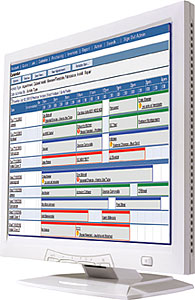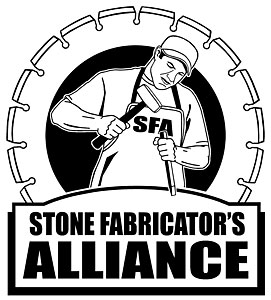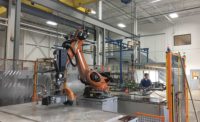
Among the factors involved in shop efficiency, production flow is key. “Slabs
are staged for cutting and then go to the SawJet,” explained Miles Crowe of
Crowe Custom Countertops. “From there, pieces go onto the CNC router and then
on to finish polish by hand. Nothing is allowed to go backwards.”
photo by Michael Reis
photo by Michael Reis
What are some of the changes that fabricators are making in their shops to increase efficiency? Has it been an adjustment in methods, an investment in equipment or something else?
Matt Lansing, Stone Innovations, Inc., Plover, WI: The topic of shop efficiency is so vast that a book could certainly be written about it, and several have been regarding most other industries.
I will start with materials and material handling. First, you need to determine how many slabs the project is going to need. If you are going to be tight with the materials on hand, then call the supplier and see if they have another slab from the lot available and place a hold on it. If something bad happens, then you will not have to remake the entire job because you can’t find matching material.
Then staging materials in front of the saw can be a huge way to improve the efficiency of the sawing process. Take the jobs for the day that need to be cut, and stack the slabs in reverse order on an A-frame next to the saw. When the sawyer finishes a slab, he can grab the next one and keep moving throughout the day. Spending 10 minutes to go around the yard looking for the slab adds up very fast.

The use of modern technology for material handling can also increase shop
efficiency. “We use an overhead crane, job carts and a jib crane to handle the
material,” Crowe said. “One man loads and unloads the SawJet.”
photos by Michael Reis
photos by Michael Reis
Another thing to think about is trying to buy your materials in bundles. When you complete a job, take the remnants from that job - almost no matter how small - and stack them back with the rest of the slabs from that same lot. Odds are you can reuse some of them for the next job coming down the list in the same material. Once you finish off the bundle, you only wind up with one or two remnants from six slabs. If you purchase three different sets of two slabs each, and you have two remnants left over from each job, your material efficiency is completely shot. Plus, when you throw in the fact that you can buy bundles at a reduced cost, you are saving money again.
These are just the basics of material efficiency. To step up to the next level, you can start to discuss programmable step-cutting saws, CNC saws with rotating tables, CNC saws with rotating heads and fixed tables, and then the “Holy Grail” of combination CNC saws with waterjetting heads - with each step being an improvement in production capabilities and overall efficiency. Decisions on these types of purchases are not easy and involve several factors that each need to be sorted out before taking the plunge. I will leave some of these for others to talk about.
Eric Pate, Technical Director/Sales, Continental Diamond Products, Inc.: Efficiency 101: First and foremost, the customer must have all information to the fabricator as soon as possible about sink and faucet selections, edge profiles and material choices, and for us, material inspection and then signoff.

Also, having a good saw operator who can do common line cutting and chooses to work with the least amount of machine movements is a good thing to have. For example: If you have two pieces plus a backsplash, cut all your parallel cuts first, then turn the table and cut the other parallel cuts after rotating 90 degrees (hopefully). That’s not the case for every job by any means, but having that mentality when cutting any job is what saves time for those without CNC bridge saws. It is how the CNC guys do it with so much faster times. It’s because of using the least amount of movement possible. It’s also how we have been doing it for the past seven years with the saw man we had.
Efficiency with equipment CNC and CNC programming: All of our jobs were pre-programmed, as the saw operator was usually one to two weeks ahead of schedule. The key is for the CNC operator to run common-size parts in order from the smallest to the largest and then from the largest to the smallest, and repeat, to minimize setup times to no more than five minutes apiece except for large islands, tub decks, batwings and odd-shaped pieces. On our CMS Brembana Concept, we ran one piece at a time because we had two machines and only one operator, along with table limitations and vacuum flow from a 5-horsepower pump.
The programmer must get into programming procedures that are consistent with every piece or job that is programmed. This allows the operator to be able to predict things and do other things in his area. The programs should be programmed in such a way that set-ups are as similar as possible from one piece to the other. We utilized our previous set-up in the software and then imported the new pieces on the table and made use of as many pods, without moving them, as possible. In most cases, the reference pins for setup stayed in the same place. Some shops use their holes in the table to always use a certain corner in the table for straight pieces and vanities. We don’t use the holes at all, but it is the exact same concept - one common reference point.
Vacuum issues: For me, a piece moving is just not acceptable. So we limited the maximum number of pods per machine to 16 to prevent too many pods on one system. When brand new, with the table, machine, vacuum pods and valves, we could run two pieces at a time with no loss of vacuum. Wear and tear on parts and normal usage scars your tables, and little by little, the vacuum starts to leak out ever so little over time. If left uncontained, this little problem becomes a costly nightmare when pieces move. The more vacuum cups you have on your machine, the more chance you get for a leak. On kitchen countertops, it was easier to do one at a time when you are running high-speed tooling. This created a pendulum-like system that kept the machines going without one stopping too early and the operator not being able to attend to it - therefore sitting idle and making no money.
Then, for us, touch-up or final inspection is the hardest area to control efficiency because of all the varying materials used in fabrication shops. Most granite could go straight off the machine to the fab area tables for inspection and sealing, and then on the A-frame after just a few minutes in that area. Some require more time - from repairing possible chips to lamination. Or it could be an issue with travertines, where you have to go back and fill all the holes and then polish the material. At this stage, it’s a huge open variable, and that’s why the other areas play such a huge part.

Job tracking programs such as JobTracker from Moraware
(pictured) also add a level of efficiency to a shop. “In order to keep the
pieces moving, shop employees can’t stop to ask questions,” Crowe said. “Each
job is accompanied by a job book that is created using Moraware. Production of
a job is not started until all of the information is in the job book.”
It is also important to watch your material flow. Ideally, the stone should be in the front of your shop for the cutting operations, in the middle for edging and CNC, and in the back for finishing. That way you are not backtracking and wasting time. When I was in school, I took a class on plant layout and learned that backtracking is three times the motion. The first time you are following the proper path, second is going backwards, and the third is going back where you came from instead of taking a new part. It is wasted opportunity and costs time and money. This also applies to correctly finished parts. The best way to be efficient in my opinion is to do it right the first time instead of taking the time to redo a mistake. This goes for everyone - from the measure guy to the installer. It is tough sometimes to get the guys in the shop to see that, but it is critical. It is important to track the mistakes to identify problem areas in your organization.
As Eric said, it is also important to have all of the information. The goal is to minimize touches of each piece. Our shop foreman gets upset when he has the job on the fabrication tables and has to stop because the project manager did not mark an overhang or reveal on the ticket, or if the sink is not marked on the ticket. In my opinion, he has every right to get upset since he may have to stop and take the job off the tables while he is waiting for the information. This adds another touch and therefore increases the likelihood of breakage.
Having the material staging areas in the right spot is key, as Matt said. All the material, not just slabs, needs to be in spots that make sense for the shop. Why take 10 steps to get material when five steps will do? By having everything close to the machines, you will save a few steps - and seconds - for each job. It may not seem like much, but all those seconds are pennies that add up at the end of the year. Efficiency comes down to making more money. That is what it is all about.
Miles Crowe, Crowe Custom Countertops, Inc., Atlanta, GA: We push a pretty high volume through a pretty small shop. We are running about 500 square feet (eight to 10 kitchens) per shift through an 8,000-square-foot workspace with seven people on the shop floor. We are constantly searching for ways to become more efficient in order to achieve this.
Our production is completely linear. Material comes in through one end of the shop and finished product goes out the other end. Material handling has to be kept to a minimum. Work only flows in one direction. Slabs are staged for cutting and then go to the SawJet. From there, pieces go onto the CNC router and then on to finish polish by hand. Nothing is allowed to go backwards. We use an overhead crane, job carts and a jib crane to handle the material.
In order to keep the pieces moving, shop employees can’t stop to ask questions. Each job is accompanied by a job book that is created using Moraware. Production of a job is not started until all of the information is in the job book. Once the job book hits the shop floor with all the necessary information, pieces can be processed without having to stop and look for answers. For example, trying to determine what size radius to put on a piece used to sometimes require that a worker stop and ask the shop foreman, who would have to call our sales manager, who would then call the salesperson, who would ultimately call the customer. This used to happen daily. Now all the information is right in front of them and work flows much more efficiently.
The most dramatic improvement we made was going completely digital - from template to layout to production. We used to make wood templates, which would have to be laid out manually on the slabs. We had one person who laid out jobs all day long. We sometimes had to involve the customer, which would mean that a 60-square-foot job could take four hours to lay out. We did not lay out the jobs until they were ready to cut. There was a lot of starting and stopping. Once the slab was laid out manually, we would then cut the slab manually. Loading and unloading and sawing was a two-man process.
With our current system, we template everything digitally. Our CNC programmer lays the job out in the programming room while he is programming the job for the SawJet and CNC. If the customer has to be involved, we now do that via E-mail or in the programming room with the use of Slabsmith [from Northwood Designs, Inc.]. The process is much faster. Slabs are then processed digitally, where one man loads and unloads the SawJet. The cutting process does not require the machine operator’s interaction. It is automatic. He can go and get the next piece while the job is cutting.
As Matt said, you could write volumes on improving efficiency. But going digital has made a dramatic improvement in our production process.

Stone World would like to extend its appreciation to the Stone Fabricator Alliance (SFA) for its cooperation in preparing this roundtable discussion. For more information on the SFA, visit www.stonefabricatorsalliance.com.
